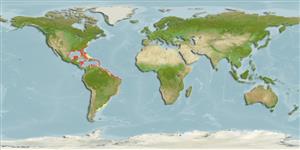>
Eupercaria/misc (Various families in series Eupercaria) >
Sparidae (Porgies)
Etymology: Archosargus: Greek, archo = anus + Latin , sargus = sea bream (Ref. 45335).
More on author: Linnaeus.
Environment: milieu / climate zone / depth range / distribution range
Ecología
marino; salobre asociado a arrecife; rango de profundidad 1 - 40 m (Ref. 115835). Subtropical; 22°C - 30°C; 41°N - 58°S, 98°W - 34°W
Western Atlantic: New Jersey, USA and northeastern Gulf of Mexico to Argentina (Ref. 4517). Absent from the Bahamas (Ref. 26938).
Length at first maturity / Tamaño / Peso / Age
Maturity: Lm 8.0 range ? - ? cm
Max length : 33.0 cm TL macho / no sexado; (Ref. 7251); common length : 20.0 cm TL macho / no sexado; (Ref. 9626); peso máximo publicado: 550.00 g (Ref. 9626); edad máxima reportada: 2.00 años (Ref. 3422)
Espinas dorsales (total): 13; Radios blandos dorsales (total): 10-11; Espinas anales 3; Radios blandos anales: 10 - 11. Large intestine makes up 90% of digestive tract and is twice the standard length, on the average; the stomach with 7 digestive caeca attached near the pyloric region. Pelvic fin coloration totally or partially dark in males; orange colored in females. Large dark spot (about same size as eye) below lateral line just behind gill opening (Ref. 26938).
Commonly found over mud bottoms in mangrove sloughs and on vegetated sand bottoms, sometimes in brackish water and occasionally also in coral reef areas near mangroves. Feeds on benthic invertebrates (small bivalves, crustaceans), as well as on plant material.
Robins, C.R. and G.C. Ray, 1986. A field guide to Atlantic coast fishes of North America. Houghton Mifflin Company, Boston, U.S.A. 354 p. (Ref. 7251)
IUCN Red List Status (Ref. 130435)
Threat to humans
Harmless
Human uses
Warning: mysqli::__construct(): (HY000/1040): Too many connections in /var/www/html/includes/func_getlabel.php on line 46
Can't connect to MySQL database (fbapp). Errorcode: Too many connections
